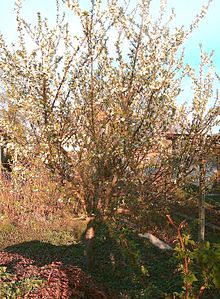Mirabelle from Nancy
The Nancy Mirabelle , also Mirabelle de Nancy , is a regularly fruiting and very high-yielding variety of Mirabelle . She is also known under the names Mirabelle from Nancy , Nancy Mirabelle , Shiny yellow Mirabelle , gold-colored plum , Great Mirabelle and Drap d'Or . It is named after the city of Nancy in Lorraine , which is one of its main historical cultivation areas.
description
fruit
The fruits are slightly larger than those of the Metzer Mirabelle and have a rounded-oval shape, sometimes they are flattened. The belly seam of the fruit can only be seen as a small line. The size and weight of the fruit are between 24 and 28 mm and between 7 and 11 grams. Both depend heavily on the location. Their firm shell is light yellow, washed out reddish-purple on the sunny side and has reddish, blotchy discoloration on the sunny side. The firm flesh is yellow, sweet and very aromatic.
The hairy stalk is short and medium-thick to thin. The stem pit is slightly incised towards the belly seam and is shallow.
history
The variety is said to have been introduced to France in the 15th century under King René of Anjou from Asia. Cultivation in France has been documented since 1490. In Germany, the Nancy Mirabelle has been grown since the 18th century. Since around 1900, the mirabelle plum from Nancy has established itself as the most important cultivar in Germany, Switzerland, Austria and France and is now the best-known and most widespread mirabelle variety in Western Europe.
Cultivation
The trees of the Mirabelle de Nancy, which are available in specialist fruit shops today, are usually very vigorous, self-fertile semi- trunks and standard trunks . The flowering time of the fruit tree is at the beginning of April. The fruits ripen between mid-August and early September.
climate
The wood of the trees is sensitive to hard frost. The flowers themselves are very sensitive to frost. For this reason, these are usually imposed or kept cool during cultivation in spring to prevent the tree from sprouting and blooming early.
ground
The trees do not make any special demands on the soil. The Mirabelle prefers moist, nutrient-rich and open soils. The mirabelle plum from Nancy gets its full taste in the wine-growing climate and in protected locations. If the soil is too wet or too heavy, or the climate is too cold, the tree will also bear fruit. However, these are smaller and far less flavorful.
Vulnerabilities and resistances
The fruits are attacked by the plum moth.
use
The mirabelle plum from Nancy is well suited for fresh consumption and is considered an excellent cake and preserving variety , but is also grown commercially for the production of jam and plum brandy.
Web links
- Fruit variety database BUND Lemgo: Nancy Mirabelle
Individual evidence
- ↑ a b c d e f g h i j Robert Silbereisen, Gerhard Götz and Walter Hartmann: Fruit varieties atlas: pome fruit, stone fruit, berry fruit, shell fruit. 2nd Edition. Ulmer, Stuttgart 1996, ISBN 3-8001-5537-0 , p. 323-325 .
- ↑ a b Without author: Our best German fruit varieties (PDF; 198 kB), Bechtholdverlag, Wiesbaden approx. 1930.

